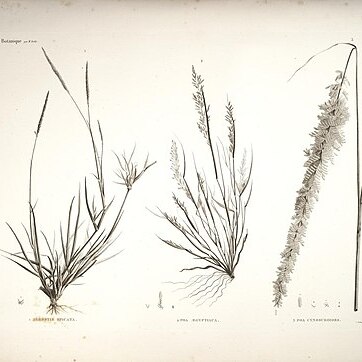Mat-forming, wiry perennial 250-1000 mm high; rhizomatous; stolons present. Leaf blade 20-300 x 1-4 mm, rigid, spiny-tipped. Inflorescence spike-like, less than 5 mm wide, branches not whorled; spikelets very densely clustered, central axis hidden completely. Spikelet 1.4-2.8 mm long; glumes unequal; lower glume 1/4-1/3 as long as spikelet, broadly ovate to lanceolate; upper glume 2/3 to as long as spikelet, narrowly ovate; lemma oblong-elliptic; anther 1.0-1.5 mm long.
Spikelets 1.6–2.7 mm long, pallid or pale green; inferior glume 1/4–1/2 the length of the spikelet, lanceolate to broadly ovate, hyaline, nerveless, glabrous, truncate to subacute at the apex; superior glume 2/3–4/5 the length of the spikelet, narrowly ovate, rarely narrowly lanceolate and as long as the spikelet, hyaline, 1-nerved, glabrous, acute at the apex; lemma as long as the spikelet, oblong-elliptic; anthers 3, 0.9–1.3 mm long.
Caespitose, mat-forming perennial; culms up to 60(75) cm tall, decumbent or erect, branched or unbranched, wiry, often with fascicles of shoots at the nodes, these arching over and rooting to form long looping stolons; basal leaf sheaths chartaceous, glabrous, terete, persistent; leaf laminas 5–30 cm × 1–4 mm, glaucous, stiff, usually involute, rarely flat, glabrous, scabrid on the margins, pungent and often painfully spiny.
Mat-forming, wiry perennial, rhizomatous and stoloniferous. up to 1 m high. Leaf blades rigid and spiny-tipped, 20-300 mm long, 1-4 mm wide. Spikelets 1.4-2.8 mm long. Panicle spike-like, not whorled, narrower than 5 mm; spikelets very densely clustered around central axis and hiding it completely.
A herb. It is a spiny grass. It keeps growing from year to year. It grows 20-30 cm high. It forms short tufts. It has runners and forms mats. The leaves are pale green and narrow. The flowers are in a cylinder shaped group. This can be 8.5 cm long and is pale yellow.
Panicle (1.5)3–22 cm long, smoothly cylindrical; primary branches not in whorls, 1–3(5) mm long, closely appressed to the axis, glabrous, eglandular, the spikelets densely packed along the whole length.
Grain 0.7–1.2 mm long, elliptic, ± triangular in section.
Stoloniferous perennial 30–60 cm. high
The leaves painfully pungent

